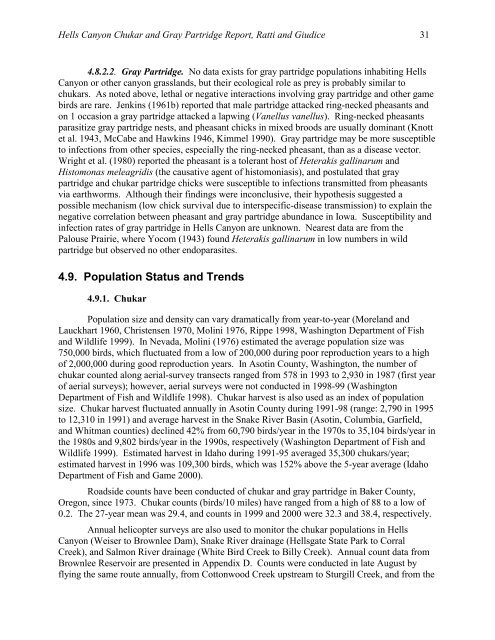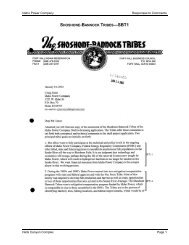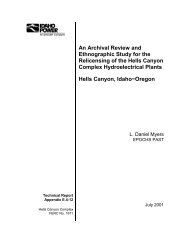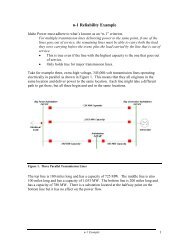Assessment of Chukar and Gray Partridge Populations - Idaho Power
Assessment of Chukar and Gray Partridge Populations - Idaho Power
Assessment of Chukar and Gray Partridge Populations - Idaho Power
- No tags were found...
Create successful ePaper yourself
Turn your PDF publications into a flip-book with our unique Google optimized e-Paper software.
Hells Canyon <strong>Chukar</strong> <strong>and</strong> <strong>Gray</strong> <strong>Partridge</strong> Report, Ratti <strong>and</strong> Giudice 314.8.2.2. <strong>Gray</strong> <strong>Partridge</strong>. No data exists for gray partridge populations inhabiting HellsCanyon or other canyon grassl<strong>and</strong>s, but their ecological role as prey is probably similar tochukars. As noted above, lethal or negative interactions involving gray partridge <strong>and</strong> other gamebirds are rare. Jenkins (1961b) reported that male partridge attacked ring-necked pheasants <strong>and</strong>on 1 occasion a gray partridge attacked a lapwing (Vanellus vanellus). Ring-necked pheasantsparasitize gray partridge nests, <strong>and</strong> pheasant chicks in mixed broods are usually dominant (Knottet al. 1943, McCabe <strong>and</strong> Hawkins 1946, Kimmel 1990). <strong>Gray</strong> partridge may be more susceptibleto infections from other species, especially the ring-necked pheasant, than as a disease vector.Wright et al. (1980) reported the pheasant is a tolerant host <strong>of</strong> Heterakis gallinarum <strong>and</strong>Histomonas meleagridis (the causative agent <strong>of</strong> histomoniasis), <strong>and</strong> postulated that graypartridge <strong>and</strong> chukar partridge chicks were susceptible to infections transmitted from pheasantsvia earthworms. Although their findings were inconclusive, their hypothesis suggested apossible mechanism (low chick survival due to interspecific-disease transmission) to explain thenegative correlation between pheasant <strong>and</strong> gray partridge abundance in Iowa. Susceptibility <strong>and</strong>infection rates <strong>of</strong> gray partridge in Hells Canyon are unknown. Nearest data are from thePalouse Prairie, where Yocom (1943) found Heterakis gallinarum in low numbers in wildpartridge but observed no other endoparasites.4.9. Population Status <strong>and</strong> Trends4.9.1. <strong>Chukar</strong>Population size <strong>and</strong> density can vary dramatically from year-to-year (Morel<strong>and</strong> <strong>and</strong>Lauckhart 1960, Christensen 1970, Molini 1976, Rippe 1998, Washington Department <strong>of</strong> Fish<strong>and</strong> Wildlife 1999). In Nevada, Molini (1976) estimated the average population size was750,000 birds, which fluctuated from a low <strong>of</strong> 200,000 during poor reproduction years to a high<strong>of</strong> 2,000,000 during good reproduction years. In Asotin County, Washington, the number <strong>of</strong>chukar counted along aerial-survey transects ranged from 578 in 1993 to 2,930 in 1987 (first year<strong>of</strong> aerial surveys); however, aerial surveys were not conducted in 1998-99 (WashingtonDepartment <strong>of</strong> Fish <strong>and</strong> Wildlife 1998). <strong>Chukar</strong> harvest is also used as an index <strong>of</strong> populationsize. <strong>Chukar</strong> harvest fluctuated annually in Asotin County during 1991-98 (range: 2,790 in 1995to 12,310 in 1991) <strong>and</strong> average harvest in the Snake River Basin (Asotin, Columbia, Garfield,<strong>and</strong> Whitman counties) declined 42% from 60,790 birds/year in the 1970s to 35,104 birds/year inthe 1980s <strong>and</strong> 9,802 birds/year in the 1990s, respectively (Washington Department <strong>of</strong> Fish <strong>and</strong>Wildlife 1999). Estimated harvest in <strong>Idaho</strong> during 1991-95 averaged 35,300 chukars/year;estimated harvest in 1996 was 109,300 birds, which was 152% above the 5-year average (<strong>Idaho</strong>Department <strong>of</strong> Fish <strong>and</strong> Game 2000).Roadside counts have been conducted <strong>of</strong> chukar <strong>and</strong> gray partridge in Baker County,Oregon, since 1973. <strong>Chukar</strong> counts (birds/10 miles) have ranged from a high <strong>of</strong> 88 to a low <strong>of</strong>0.2. The 27-year mean was 29.4, <strong>and</strong> counts in 1999 <strong>and</strong> 2000 were 32.3 <strong>and</strong> 38.4, respectively.Annual helicopter surveys are also used to monitor the chukar populations in HellsCanyon (Weiser to Brownlee Dam), Snake River drainage (Hellsgate State Park to CorralCreek), <strong>and</strong> Salmon River drainage (White Bird Creek to Billy Creek). Annual count data fromBrownlee Reservoir are presented in Appendix D. Counts were conducted in late August byflying the same route annually, from Cottonwood Creek upstream to Sturgill Creek, <strong>and</strong> from the
















